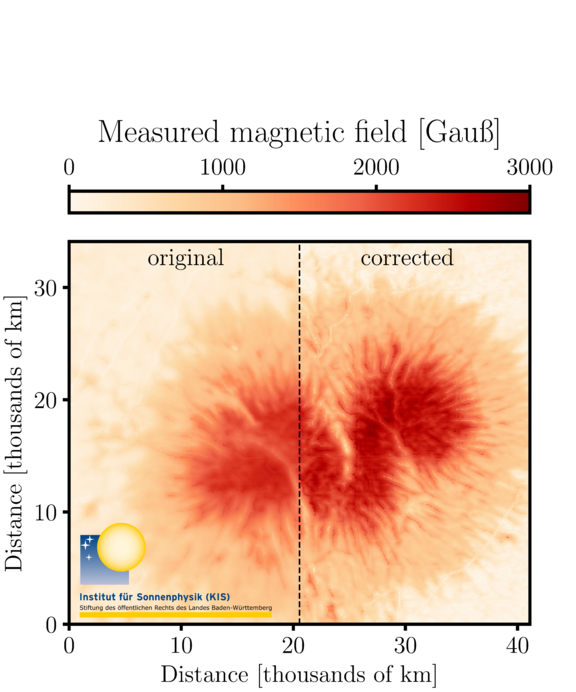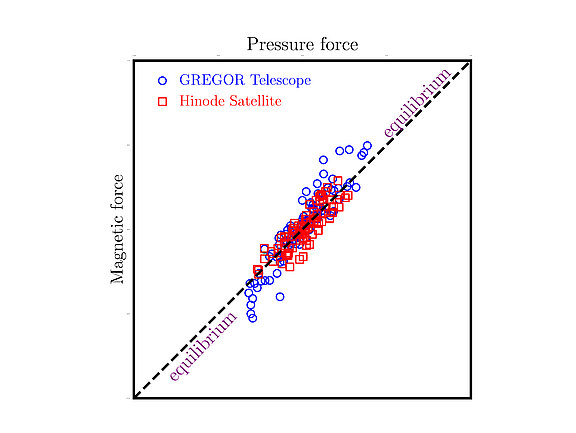Unstable magnetic configurations in the vicinity of sunspots can cause explosions known as coronal mass ejections and solar flares, especially during sunspot maximum. These explosions can have a serious impact on satellite communications. The strongest explosions can lead to power failures.
Stable sunspots can exist on the Sun's surface for periods ranging from a few days to several months and they are the key to understanding the solar activity cycle. While it was assumed in the early 1970s that the reason for the long life of sunspots was the fact that an equilibrium is reached between gas pressure and magnetic field, this equilibrium has so far been very difficult to explain due to disturbances in the magnetic field. Until now.
The scientific journal Astronomy & Astrophysics recently published a study on the development of a new method for analysing the stability of sunspots. As part of this study, an international team - led by scientists from Germany in collaboration with colleagues from Sweden, the USA and Spain - applied this new method to observations with the German GREGOR solar telescope. During this process, physicists at the Institute of Solar Physics (KIS) in Freiburg succeeded in extending and improving a technique, developed originally at the Göttingen Max Planck Institute for Solar System Research, in such a way that the influence of Earth's atmosphere could be removed from the observations. The magnetic field measurements carried out with the new method at the German GREGOR solar telescope now achieve a quality previously only attained with satellites, but at a much lower cost. A comparison between the measurements before and after the correction is shown in figures 1 and 2.
The development of a powerful numerical programme, led by Dr Juan Manuel Borrero at the Institute of Solar Physics (KIS) in Freiburg and funded by the German Research Foundation (DFG), enabled the researchers to analyse the polarised light emitted by the Sun. This analysis showed that the magnetic forces inside sunspots are compensated by pressure forces in such a way that equilibrium is strictly maintained (see figure 3). This discovery explains why sunspots can survive for so long on the surface of the Sun. In the future, it could be used to detect when sunspots become unstable, making it more likely to trigger the above-mentioned explosions that potentially threaten modern life on Earth.
Figure 1: Temperature measured (in degrees Celsius) in the sunspot observed with the German GREGOR telescope. The left side of the image shows the temperature measured using the original data, while the right side shows the temperature measured after correcting the disturbances caused by Earth's atmosphere.
Figure 2: Magnetic field measured (in Gauss) in the same sunspot observed with the German GREGOR telescope. The left side of the image shows the magnetic field measured using the original data, while the right side shows the magnetic field measured after correcting the disturbances caused by Earth's atmosphere.
Figure 3: Magnetic force (vertical axis) versus pressure force (horizontal axis) in a sunspot observed with the German 1.5 metre GREGOR solar telescope (blue circles). Next to it, the same sunspot observed with the Japanese 0.5 metre Hinode satellite (red squares). The diagonal dashed line represents the equilibrium line where the compressive force is equal to the magnetic force. All data points are located along this equilibrium line, which indicates that the sunspot is in equilibrium and therefore stable.
![Figure 1 [Translate to Englisch:]](/fileadmin/_processed_/7/9/csm_2025-06-23_Press_release_Borrero_figure1_d55fc92e76.png)

